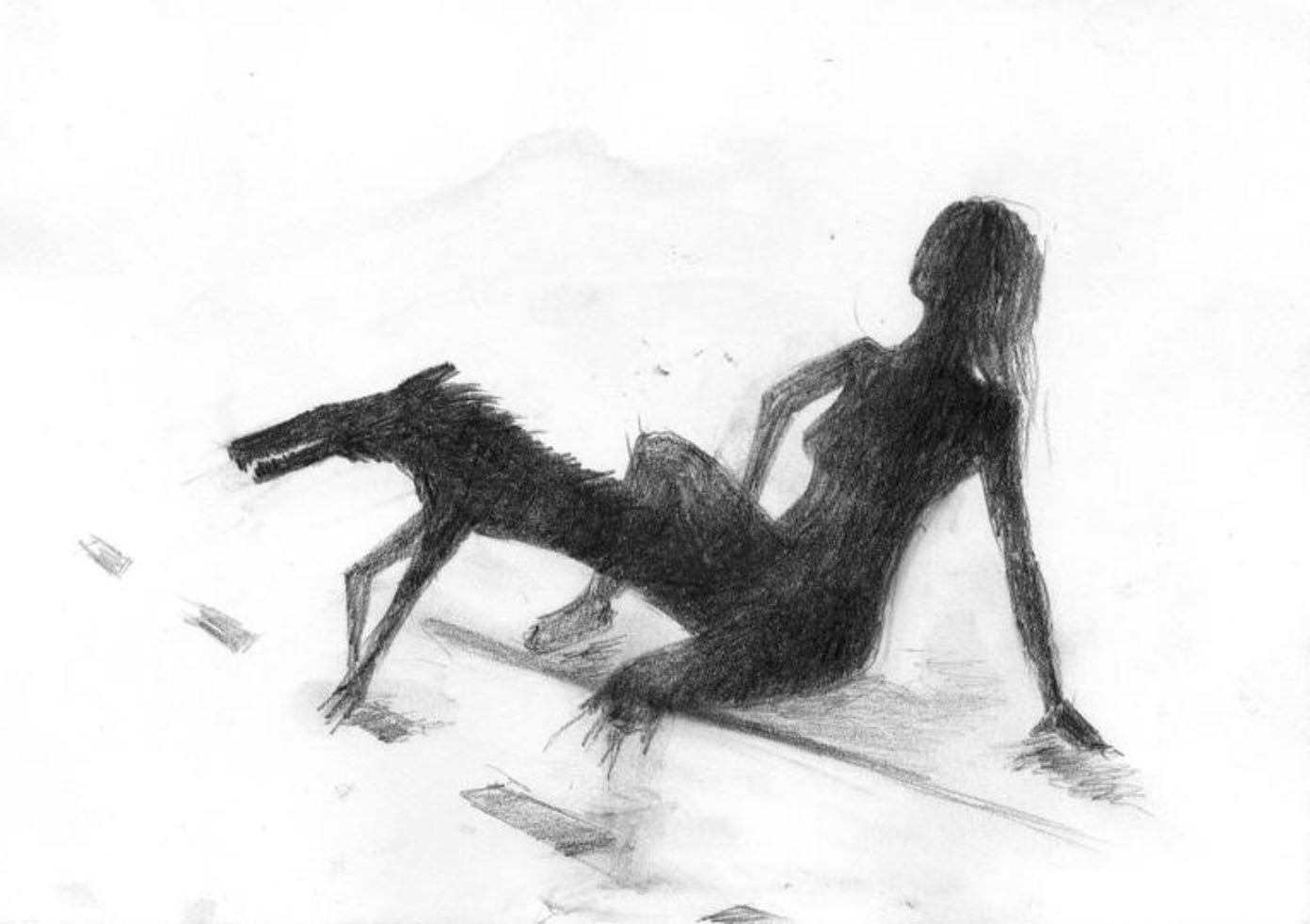An exploration of our connections with animal symbols in the collective consciousness examines how these symbols intertwine with themes of fear, survival, the body, and language.
Dina Shehata
Translated from the Arabic by Rana Asfour
As we transition from the nurturing confines of the womb, we embark on our journey into the world. Leaving behind the warmth of our mother’s embrace, we move from sleeping beside her to creating our own space in our beds. In those early days, the bed symbolizes comfort — a sanctuary where playful adventures come to life. It’s the perfect place for hide-and-seek or for bringing vivid new worlds to life with our neatly arranged plastic toys, lined up like a small army ready for imaginary battles. In this world of make-believe, we become heroes in conflicts that exist only in our minds, hidden from the view of others.
Underneath the bed, your pet — let’s imagine a white cat — snuggles comfortably beside you, its soft fur leaving a scattering of white on your cotton pyjamas. Your hair, wild and frizzy after a day of endless adventures, is a testament to a lively childhood. However, beneath this very bed, something unexpected is about to happen. Playtime will no longer be about play; your cat so much more than a spirited companion.
When you slip under the bed in hiding, all you have is your trembling body and a cat that, while it doesn’t quite grasp what’s going on, stays faithfully by your side. It doesn’t question your retreat, nor does it protest against the shadows or your unease. Instead, it simply curls up next to you, its steady breathing a soothing rhythm, while its fur falls onto your pyjamas. Without even realizing it, the cat offers you something unique: companionship in silence.
In that moment, you’ll realize that cats, in contrast to dogs, don’t bark or rush to alert anyone for help. Their mere presence whispers, “Let’s hide together; that’s all we can do for now.” Through this, you come to understand that sometimes survival doesn’t hinge on having a voice, but rather on a quiet companionship that embraces you just as you are — scared, young, and bewildered by everything unfolding around you.
As you hold your breath beneath the bed, your small body curled up with the cat, bedtime stories rush through your mind, calming your fears. You think of the wolf — the one that gobbled up Little Red Riding Hood and her grandmother — the very same wolf that Joseph’s brothers maliciously used to hide their crime. You contemplate the legends surrounding this elusive creature, always a part of tales yet never truly glimpsed, but endlessly blamed for mischief. You start to wonder: Why is it always the wolf? Why not another villain? Was the wolf ever actually there, or do we simply need him to face a truth we’re too scared to confront?
Then another doubt creeps in. What if, you wonder, the wolf wasn’t truly a monster? What if he were merely a witness? Or perhaps a victim like us, caught in the turmoil of the tale without any means of defence? What if the wolf symbolized any one of us, perceived as a threat by others simply due to our own fears?
Hiding under the bed is not just a physical act; it serves as an early lesson in survival, a way of pretending you don’t exist, of shrinking back to avoid being seen. Over time, you begin to understand that the true wolf isn’t always lurking outside; sometimes, it’s within you, not as a predator, but as a part of yourself that learns to conceal its presence so as not to be devoured.
The wolf you once imagined lurking behind the door has morphed into the calm demeanor you display when facing those who shout. It’s the steady gaze you cast upon those waiting for your tears, along with your choice to walk away from futile arguments. This has become your survival tactic, a way to shield your emotions, and a means of carrying a story without ever voicing it.
The wolf was never a loud presence; instead, it taught a simple lesson learned while hiding beneath the bed: stay quiet, it warned. It was always about blending in, avoiding attention, and preserving oneself — even if it meant appearing a bit strange, stiff, or distant. Simply put, the wolf is who we are when we cannot be anything else.
In our culture, the wolf symbolizes what’s too difficult to express directly. It takes on the role of the scapegoat, sparing us from the pain of uncovering the true offender. We simply say, “The wolf ate him,” implying an end to further questioning. The wolf becomes a shield, a convenient metaphor for all the truths we’re too afraid to reveal.
What if the wolf symbolized every individual who chose to stay silent? Each person who kept themselves hidden away? Anyone who believed that survival didn’t hinge on being loud, but rather on taking slow, shallow breaths, moving quietly, and avoiding eye contact?
We were taught to think that silence signifies wisdom and that remaining quiet indicates our contentment. Yet, we never paused to reflect on who truly benefits from our silence. Who is shielded, and who ends up being weighed down by it?
In our culture, silence isn’t simply a stance of neutrality; it’s a calculated strategy. It’s a means to dodge punishment, uphold appearances, evade the wolves, or even to become one with them. So, is silence truly a sign of wisdom, or is it in fact a reflection of fear? Is it an inherent part of our existence, or merely a weighty legacy passed down through generations, preventing us from uncovering the deeper truths hidden beneath its surface?
In moments of panic, don’t try to make sense of things; instead, seek out a companion who asks for no explanations. Look for something that breathes alongside you, empathizes without needing details, moves in sync with your heartbeat, and recognizes that fear has its own language, one that needs no translation.
And that was why the cat was there under the bed.
It might not have grasped what was unfolding, but it could sense you. It lay beside you under the bed, your eyes locked in a quiet connection, and amid the silence, something settled; an unspoken confession, a hidden promise to endure together.
Every household has a story of an animal that witnessed a moment of panic. A dog sat beside a child who was crying for no apparent reason. A bird that stopped chirping, as if it had sensed fear in the air. These animals couldn’t speak, but they understood. They didn’t interfere, yet they also didn’t abandon you.
They may not have had the words to express themselves, but they understood matters deeply. They noticed people’s hidden struggles and embraced them without needing any explanations. Their mere presence serves as a comforting response to vulnerability, reminding us that we are alive and not alone in our instincts. They serve as quiet witnesses to our unvoiced truths, much like the wolf, which is not a monster but rather a reflection of hidden fears — the very things that make one shrink back in the dark, exposing what one often tries to hide.
Beneath the bed, a silent language came to life. It wasn’t a language of words, but one conveyed through glances, quivers of the body, and held-back breaths. The cat understood it, the girl sensed it, and the wolf she feared was woven into its fabric.
A language that lacks an alphabet yet remains precise, honest, and raw. It does not entertain eloquence or allow for deception because it is the language of survival. Beneath the bed, there’s no space for metaphor, only direct references and actions — only the heart when it races unexpectedly.
In that narrow space between fear and life, a different kind of knowledge emerges. It’s a type of understanding that goes beyond words, residing within us and revealing itself later through expressions, silences, and incomplete stories.
Underneath the bed, a first language began to emerge — a silent form of communication that needed no words to be grasped.
Fear strips language of its flourish. Words dry up on the tip of the tongue, sentences splinter into disjointed fragments, gradually fading into silence. When searching for refuge, one isn’t looking for words; rather, they are trying to stay unnoticed. In this way, silence becomes a form of armor, and the choice to embrace stillness turns into a defensive tactic. In this context, silence evolves into its own language, its intent altered. It’s no longer simply for speaking; instead, it becomes a tool for concealment.
When fear strikes, language slips into a more primal form. It becomes a gesture, a gasp, a fleeting glance, a huddled form. Withdrawing and shrinking, it hides alongside you under the bed, holding its breath, blending into the shadows.
Suddenly, it becomes clear that everything you’ve learned about communication fades into insignificance. The language found in books, speeches, and everyday conversations proves inadequate for the demands of survival, which calls for a much deeper mode of expression — a physical, instinctive, and raw form of communication that resonates only with those who truly understand it.
That’s why the wolf was also there, tucked under the bed — not as a villain, but rather as a survivor. It understood that words can betray, and sometimes silence is the only way to move forward. The wolf embodies true survival instincts, knowing when to keep quiet. Contrary to the usual narratives, it isn’t always a fierce predator. In the depths of the forest, the wolf strikes only when absolutely necessary and howls only when the danger has passed. It recognizes the value of retreat, keen observation, and stealth — essential skills for survival.
When you hide, you come to realize that you are more akin to the wolf than you ever imagined. Like the wolf, you pause to observe, calculate your moves, hold your breath, and learn to navigate life without being noticed. The creature you once feared in your childhood may have actually taught you your first lessons in caution and survival.
Besides, wolves do not lead solitary lives. They thrive within a pack, building strong bonds and connections that often go unnoticed. Yet, time and again, they find themselves blamed, weighed down by guilt, and cast as the villains in every tale. Perhaps this stems from their survival instincts, their silence in the face of adversity.
The wolf is a true survivor because it never waited for anyone to clear its name. Instead, it stayed hidden in the shadows, on the outskirts of the narrative, all the while keeping on the move — light, quiet, and utterly cautious, just like the girl beneath the bed, absorbing her first language through a haze of fear.
Huddled under the bed, the girl shivered quietly, the cat curled up by her side, offering silent companionship. Inside her, the wolf stirred but didn’t growl — its presence merely waiting for acknowledgment. In that small, cramped space, it becomes clear that fear isn’t defeated by making noise; rather, the words that can truly save you are often the ones you have yet to learn how to express.




